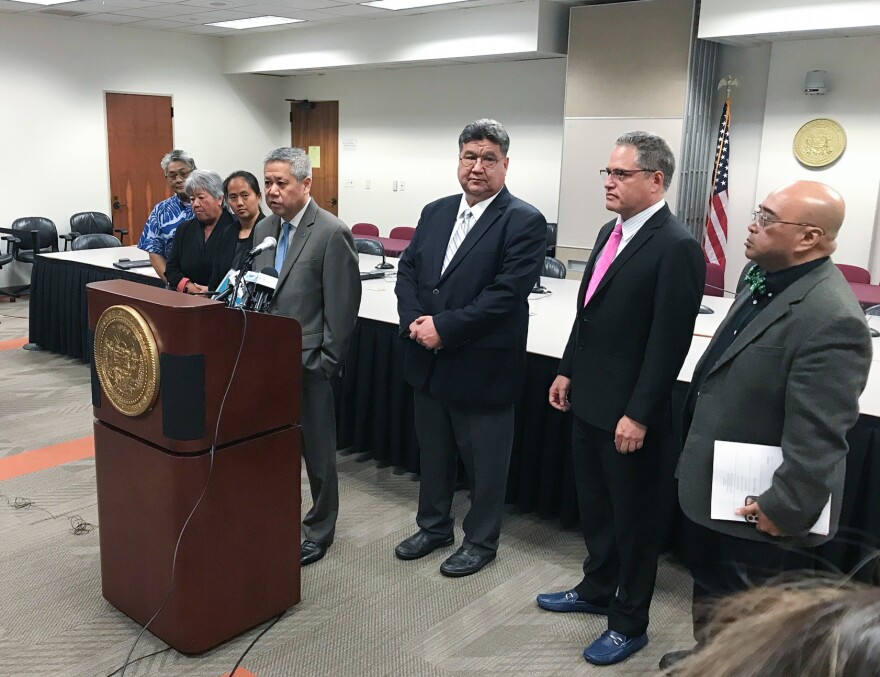Friday is the final scheduled day for the Hawaii Legislature’s 2020 session. It was hallmarked by social distancing measures aimed at preventing the spread of COVID-19.
The coronavirus pandemic forced lawmakers to close public access to the state Capitol, end in-person testimony on legislation, and broadcast all legislative hearings for remote viewing.
Anyone trying to follow deliberations at the Capitol over the past two months, has likely spent some time on hold listening to elevator music. The only way to watch daily hearings has been to stream them online or to tune in live on Olelo Community Media.
In some ways, that represents an improvement in public access. Previously, hearings and floor sessions were not regularly broadcast for remote viewing. This was particularly disadvantageous for Neighbor Island residents, for whom appearing at the Capitol in person can be prohibitive.
But in most other respects, the current system provides fewer opportunities for the public to participate in government.
Following the action can be difficult, with committee chairs often calling recesses for members to discuss a proposal. In the era of social distancing that means the microphones and cameras, now the public’s only window into the legislative process, are shut off.
That was the case in a June 23rd meeting of the House Committee on Lower and Higher Education, when Chair Justin Woodson called a recess for decision-making on two measures; one pertaining to data collection at public schools and the other on the construction of school facilities.
For the next three minutes, lawmakers could be seen on live stream video, but not heard. When audio resumed, both measures passed unanimously, with little indication of what was discussed.
On June 25, members of the Senate Committee on Public Safety, Intergovernmental, and Military Affairs reviewed a bill that would have created clearer standards for the use of force by police agencies. After reading written testimony, Chair Clarence Nishihara called a recess, but could be heard discussing what the committee planned to do before being directed by a legislative aide to switch off cameras and microphones.
After a minute of elevator music and a screensaver, the sound and video returned, and the committee approved a measure with the lone dissenter, Ewa Beach Sen. Kurt Favella, audibly expressing surprise at the procedure.
Sandy Ma with the good governance watchdog Common Cause Hawaii says the remote viewing system has been problematic.
“There are so many process problems with this current session it's even just hard to begin,” she told HPR in an interview.
Ma says she has observed audio quality too distorted to understand, camera angles making it impossible to identify speakers, and scheduling errors resulting in votes and hearings taking place without being broadcast.
However, her biggest issue is with the restrictions on public participation. Normally, residents can appear in person to voice their concerns about proposed laws and even answer questions from lawmakers. Ma says that makes for better government and better policy. In the era of COVID, only written testimony was accepted, which she believes is an inadequate substitute.
“I understand that we’re all trying, but we’ve had months to do something better,” she noted.
The Maui County Council and Honolulu City Council have been meeting during the pandemic and accepting live constituent testimony using video conferencing and in-person appearances. Maui Councilmembers had such a system up and running as far back as late March.
In a normal year, not every hearing and vote at the Capitol is broadcast live. House Majority Leader Della Au Belatti says expanding streaming capacity took precedence over in-person testimony.
“That [remote testimony] just added a complicating factor that we could not deal with in this time period,” Belatti said. “I think we would all want in-person participation, but this is the reality of 2020.”
It is worth noting that in previous sessions, lawmakers have considered and failed to pass measures that would have created a system for remote testimony. That is a move long called for by Neighbor Island residents, who are now forced to fly to Oahu if they wish to participate.
“Residents from Neighbor Islands don’t have the same chance to testify at hearings,” said Nicole Woo, senior policy analyst with the Hawaii Appleseed Center for Law and Economic Justice. “It’s truly unfortunate that they haven’t addressed the need for remote testimony, before the pandemic.”
One measure from the 2019 session that would have established such a system even noted that legislatures in Alaska and Nevada had already adopted procedures for submitting feedback remotely.
When asked about the interrupted sound and video feeds during lawmakers’ deliberations, Majority Leader Belatti told HPR that the practice is in line with normal House rules allowing committee chairs to call for off-the-record discussion.
“It is also the chair’s discretion whether there will be further discussion on the record,” Belatti noted. “So what you’re seeing is just the real-time capturing of what our normal processes are.”
The Legislature and the Judiciary are the only bodies exempt the state’s Sunshine Law, which requires government meetings to be held in public view.
Gov. David Ige suspended the open meetings requirement in March with his first emergency proclamation order in March. He has yet to reinstate it.



